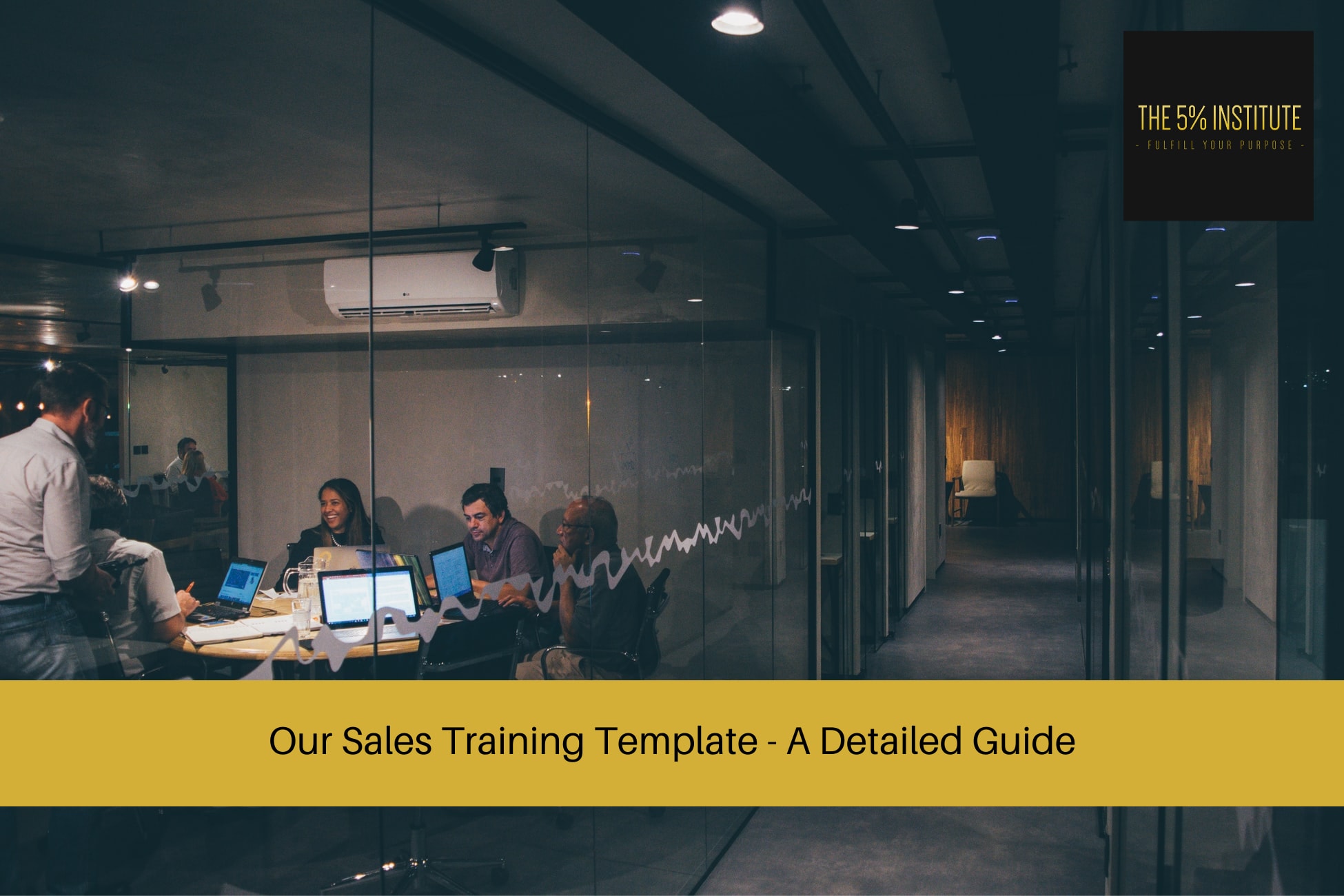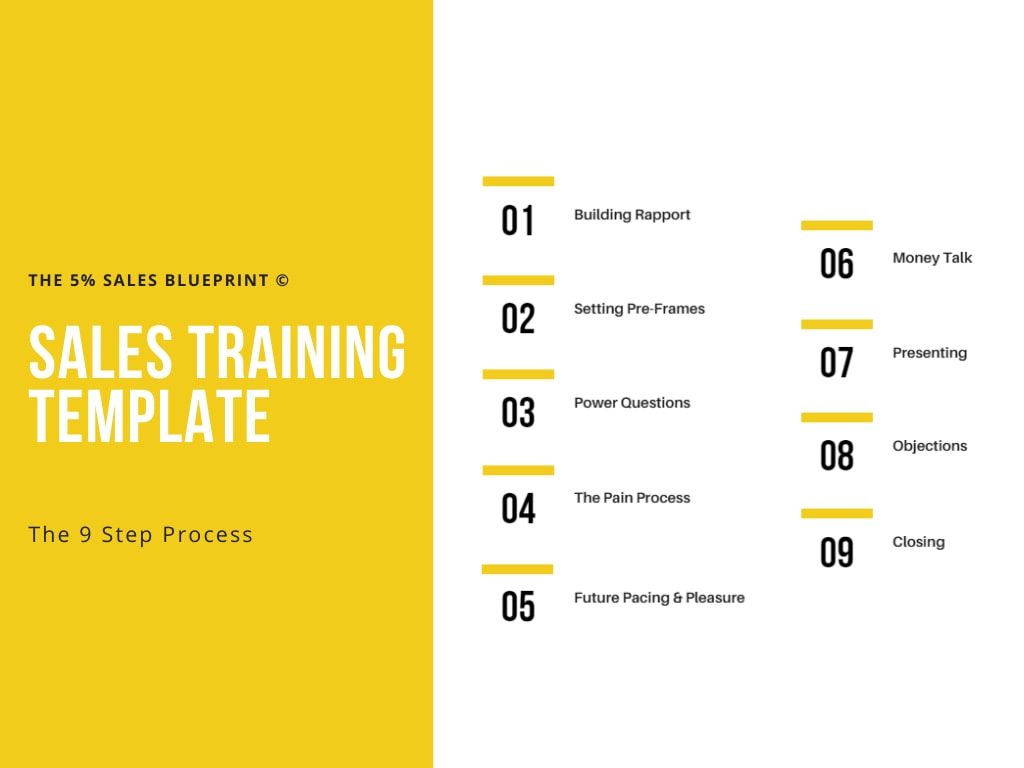
Our Sales Training Template – A Detailed Guide
In this guide, you’ll learn the exact sales training template we use to help serve Business Owners and Sales Professionals across multiple industries, and multiple countries.
Learning and following a sales process would have to be the most important thing you’ll ever learn in sales, because it’ll deliver something you’ll need to thrive in selling.
And that thing – is consistency.
Read on to learn our sales training template, and how you can implement it into your sales strategy.
The Benefits Of Using A Sales Training Template
Also known as a sales formula or sales framework; this sales training template is key to helping you and your staff win sales by using a consultative methodology.
The benefits of using this sales training template include:
- It creates a system; allowing you to train your staff nu using a road map
- Certainty – for both you and your staff
- It teaches your staff to control the process and sales conversation in a consultative way
By following this sales training template, your team will be a lot more confident when talking to potential clients, because they won’t have to worry about what to say next, what to ask, or what you should do next to move the sale forward.
Our Sales Training Template – A Detailed Guide
Our sales training template is based on our online sales training program, called The 5% Sales Blueprint; which is a step by step framework to help you close more clients a lot more consistently, using a consultative and non-pushy method.
Below is an image breakdown of what our sales training template looks like. Learn each of these steps if you want to follow a proven consultative sales method:

Rapport
The first part of any sales conversation, as well as our sales training template is building rapport with your potential clients.
Without building rapport, your potential clients won’t feel comfortable disclosing anything and your sales conversation won’t move forward.
Rapport is important because people buy from people they like and trust.
By building rapport, you’ll be able to ask deep diving questions that can ultimately lead to a buying decision.
Related article: A Guide To Building Sales Rapport
Pre-Framing
The second step in our sales training template, is what makes our sales training and process very different from the others out there.
We teach something called a pre-frame.
The deep diving sales conversation you will have with your potential client, is called the frame.
You’ll have the opportunity to ask questions, and ‘frame the conversation’ in a way which will ultimately lead to a decision being made – either proceeding with a sale or deciding you may not be the right fit for one another.
The pre-frame is the conversation you have prior to the frame; in this case, it is what’s discussed prior to going into your deep dive sales conversation.
During the pre-frame, you want to cover three important things:
- Ensure all decision makers are present
- Let them know that you’ll be asking a lot of questions, to work out whether you can in fact help and serve them and their needs
- Give them comfort that at the end of the conversation, it is more than OK to say no if they’re not interested. Also let them know that many people use the “I need to think about it” as a way of covering for no. By giving them comfort, they’ll be more transparent.
The reason the pre-frame is key, is for two reasons.
Firstly, you’re removing two core sales objections up front – the I need to think about it objection, and I need to speak to objection.
Secondly – you’re getting permission to ask deep diving questions, which is the next step in our sales training template.
Using a pre-frame will be a game changer for your business and overall sales process, because you’ll get to the underlying truth faster than using a traditional sales methodology.
While pre-framing your potential clients; on a side note – you also want to qualify them and ensure you’re speaking with the right person, and that they’ll benefit from your product or service.
Before we get into the question side of things, we’ll quickly cover the importance of qualifying your potential clients.
Qualifying
Another important step in our sales process / sales training template is qualifying your potential clients prior to going into a deep dive sales conversation.
Many Sales Professionals make the mistake of speaking with people they think are potential clients – but are not qualified to either afford their product or service or make a buying decision.
By qualifying people early, you’ll save a lot of time, energy, and money.
The qualifying framework we recommend adding to your sales training template, is borrowed from an acronym called BANT.
Originally designed by IBM, it’s an easy to remember framework to remember what you need to ask to qualify your potential clients correctly.
BANT stands for:
- Budget
- Authority
- Need
- Time frame
Further reading: Qualifying Sales Leads – A Step By Step Guide
The Key Ingredient For Your Sales Training Template – Questions
The most important part of your sales training template, as well as your overall ability to close more sales – is the art of asking the right questions.
At The 5% Institute, we emphasise the importance of asking questions because we believe in using a consultative sales approach.
By asking the right questions – you’ll be able to help guide your potential client toward the sale and help them sell themselves on the need for a solution.
During your sales conversations, we recommend asking the following question examples:
- Finding pain
- Learning about their ideal outcome
- How they make buying decisions
- Why they’re speaking with you
- How long they’ve had their issue
We’ve written numerous articles on questioning and question categories, and recommend you read them to learn more. Check out the linked articles below to find out how.
- Sales Probing Questions
- Open Ended Sales Questions
- 10 x Questions To Ask A Potential Client
- 5 x Closing Questions To Win More Sales
The Pain Process
Pain points; in a sales context, are the things that cause discomfort to your potential clients in their business, day to day activities, and their everyday lives.
Everyone has different pain points, and they come in different levels of pain.
Pain points are generally based on different levels of pain; and the measurement for the level of pain will be based on your potential client’s perceptions, and what they categorise their pain points as.
Why Is Finding Pain So Important?
People buy for two emotional reasons – to escape pain and move towards a desired outcome; or pleasure.
All our buying decisions are subconsciously made by this weighting scale.
Whenever we buy anything, we subconsciously make a quick calculation; will this purchase mean more pain (ie: loss of money verse reward), or will it mean more pleasure (make me feel better than my current state)?
Human beings are meaning making machines; and all our decisions – including buying decisions, are governed between contrasting pain and pleasure.
Pain points are important to find when conversing with your potential clients, because without finding their pain points there is a high likelihood you won’t be able to close the sale.
People buy to escape pain, so it is imperative to discover what those pain points look like.
Below is a linked article to learn how to find pain, in a non-intrusive way.
Further reading: Pain Points & Sales – Your Ultimate Guide
Desire & Pleasure
The second reason as to why people make buying decisions, and next step in our sales training template – is pleasure.
People buy things to also move towards a pleasurable state.
They want a desired solution and outcome.
Although it is absolutely critical to learn about a person’s pain points; it’s also very important to learn what a positive future and outcome looks like too.
By getting them to explain what their desired outcome looks like; you get them to imagine what it would look like if they no longer have their pain points and issues at hand.
This makes it a low easier to sell later – because you’re already getting them to think about finding a solution – and what the future will look like with one.
Discussing Money
Discussing money should be another very important part of your sales training template, because you can use the discussion to build monetary value around what a solution for their problem and pain points will mean.
When you’re discussing money, you ultimately want to understand two important things:
- What is it costing them by having these issues? Learn the financial and personal impact of what the pain points mean.
- How much would they pay to fix it, and have a solution?
Discussing this here makes asking for the sale, and your closing questions a breeze.
Presenting
Once money has been clearly discussed, the next step in your sales training template should be presenting your solution.
Many Sales Professionals handle presenting incorrectly and do something we call ‘premature presentation’.
As per our article in Entrepreneur, premature presentation is when you present your product or service prior to understanding what they need solved and hope that something you say sticks and resonates.
This spray and pray method are outdated and won’t help your closing rate.
Instead – when you’re presenting your product or service, we recommend you do so by prescribing it to their pain points and demonstrate how each of their problems will be solved with specific features and benefits you have.
Using a prescription approach as a specialist would, will align you as a trusted adviser, rather than just another salesperson trying to make a quick sale.
Handling Objections
The second last stage of our sales training template is handling their areas of concern and objections.
Although many people advocate using word tracks and sales scripts, we recommend not using either.
Instead – we recommend using a simple and easy to remember objections framework.
The framework is:
- Listen carefully
- Repeat back the objection, and ask them to expand
- Validate the area of concern
- Re-frame the concern
- Confirm you’re on the same page
To learn how to do this in detail, read the article here to find out how.
Once you’ve handled all their areas of concern, simply ask if they’d like you to help them achieve what they intend to have solved and have them sign any agreements you may have in place.
Closing – The Last Step In Our Sales Training Template
The final part of our sales training template – is asking for the sale; also known as closing.
Although many Sales Professionals and Business Owners focus on this the most; what you should realise, is that if you follow each of the mentioned steps before this – closing should actually be easy.
A sale is closed long before you ask for the sale.
My favourite question to ask, is “Would you like my help with *insert problem to be fixed*?”
It’s not pushy, and it’s consultative.
More importantly; it’s built on trust. If they agree, then you can discuss terms, payment methods and much more.
Final Thoughts On Our Sales Training Template
This sales training template is a great framework to use to close more sales, because it gives you consistency, as well as an easy to follow road map.
By following this process, you’ll lead your potential clients on a journey and positive sales experience, rather than position yourself as just another salesperson or commodity.
The sales process is the most fundamental, and important thing to master in sales if you wish to close consistently.
If you’d like to learn about our sales process in more detail, as well a show to close more sales without being pushy, you can join the 7 Day Sales Challenge for free here.
Want To Close Easier?
Are you interested in learning this sales training template in more detail?
If you’d like to learn how to sell in a consultative way without breaking the bank, learn about our easily accessible and affordable online sales training course, called The 5% Sales Blueprint.
You can learn more about the program, and how it can help you, by clicking the linked page below.
Learn more: The 5% Sales Blueprint Online Sales Training Course



